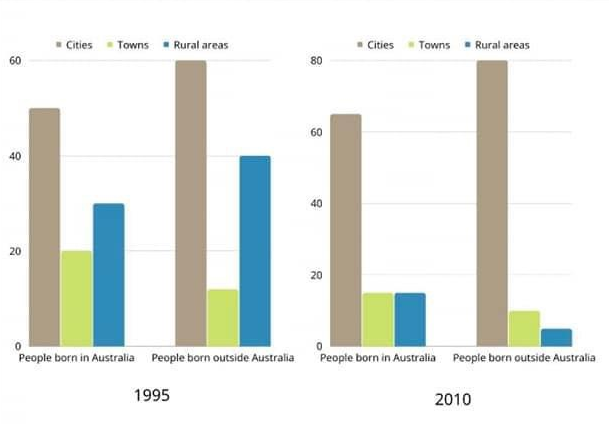[Sanjida I] Writing Practice Test 1061270
Task 1
You should spend about 20 minutes on this task.
The bar chart below describes some changes about the percentage of people were born in Australia and who were born outside Australia living in urban, rural and town between 1995 and 2010.
Summarise the information by selecting and reporting the main features and make comparisons where relevant.
You should write at least 150 words.

The given bar graph evaluates some changes in the percentage of people born in and outside of Australia who lived in urban, rural, and town respectively from 1995 to 2010.
In 1995, the majority of people lived in cities both born in and outside of Australia. Similarly, a less portion of people both born in and outside of Australia lived in town in 1995. The average population lived in rural areas in both cases.
Now coming to 2010, a similar scenario can be seen for the people living in cities in both cases. But in 2010, the same percentage of people born in Australia lived in both towns and villages which is about 17%. On the other hand, the scenario is a little bit different for people born outside Australia. A minority of people lived in rural areas who were born outside Australia.
So for both cases, it can be concluded that most people are more likely to live in cities than towns and rural areas.
Task 2
You should spend about 40 minutes on this task.
Rich countries often give money to poorer countries, but it does not solve poverty. Therefore, developed countries should give other types of help to the poor countries rather than financial aid. To what extent do you agree or disagree?
You should write at least 250 words.
Yes, I agree that only financial support can't remove or solve the problem of poverty. Rich countries have a lot of resources for producing money like industries. If they borrow human resources from poorer countries and give money for that then that could be a solution to poverty solvency.
Human resources are key to the development of any country. But due to lack of money, poorer countries can't make their population as human resources. Some developing countries like Bangladesh are utilizing their population as human resources but not up to that level. If developed countries like the USA, UK, Russia, etc. come forward to help the poorer country to remove poverty by making their population to human resources then the problem could be solved to some extent.
Now the question arises how this can be done. This can be done in many ways like establishing new industries inside the territory of poorer countries and giving job opportunities to the poor native people by training them or hiring them in developed countries and giving them the opportunity off foreign income and remittances. Again, importing goods like clothing, spices or handmade items or crafts from poorer countries can be another solution. Most importantly, educating the people of the poorer country and making the nation educated is the long-term solution to resolve the problem of poverty.
If the rich or developed countries come forward with these steps rather than giving financial aid, the poverty can be resolved rather say removed from the poorer countries within a limited time and for the long term.
Community’s feedback
Sorry! We couldn't find any contents.
Leaderboard:
| # | User | Score | Time | |
|---|---|---|---|---|
| Kento Nanami |  | 8.5 | 52:31 | |
| Nayef Alhajraf |  | 8.5 | 60:00 | |
| Ella Ruppo |  | 7.5 | 59:39 | |
| 4 | chengxi yu |  | 7.0 | 00:00 |
| 5 | avin chui |  | 7.0 | 59:11 |
| 6 | 癫 火 |  | 7.0 | 59:51 |
| 7 | Li Xuefeng |  | 6.5 | 03:46 |
| 8 | Chanisara Wongkongsang |  | 6.5 | 56:37 |
| 9 | Dan H |  | 6.0 | 50:41 |
| 10 | Carlo Di Giacomo |  | 6.0 | 60:00 |



